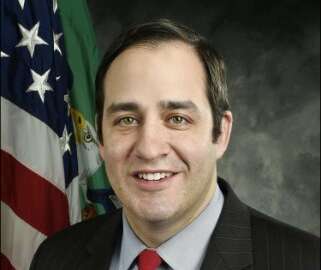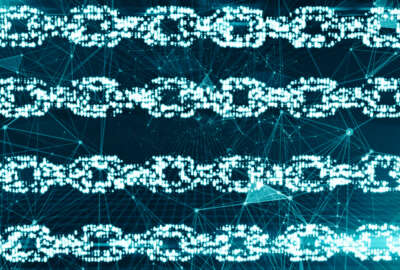
Beyond Bitcoin: How federal agencies are discovering new uses for blockchain
By breaking blockchain down to its core concept, federal agencies are coming up with new uses for the innovation.
You rarely hear blockchain mentioned outside of the context of Bitcoin, the cryptocurrency taking Wall Street by storm. That’s because the concept was created to make cryptocurrencies possible. But defining it that narrowly would be like calling the internet a system to allow Defense Department computers to communicate. Just because that’s how it was conceived doesn’t mean that’s all of which it’s capable.
“So at the core, the blockchain is a ledger,” Mark White, chief technologist at Deloitte Consulting, told Federal Drive with Tom Temin. “Think of a general ledger. Think of an accounts payable or accounts receivable ledger. Think of perhaps a non-financial ledger like a list of land records or a list of professional licenses.”
By breaking blockchain down to its core concept, federal agencies are coming up with new uses for the innovation. Ledgers are an important tool in the bureaucrat’s repertoire. Agencies use them to keep records, like birth certificates or veterans’ benefits. They track fixed assets like vehicles, office furniture, even offices themselves, and the value of those assets.
Blockchain is a ledger system that allows each individual, group or agency to keep their own copy of the record, yet still ensure that the copies match. And that’s the point of blockchain, White said. It’s the digital equivalent of a trusted third party, certifying transactions are completed in the way that every party agreed to.
“So what if those records were in a distributed ledger so that you could digitally access them?” White asked. “You would know that they’re the truth, and in fact, they come with a thumbprint, a cryptographic signature to certify that they’re the truth. It’s the same as a notarized document, but you can access it freely from wherever you are. You can then distribute it digitally for whatever purposes.”
John Hill, assistant commissioner of financial innovation and transformation at the Treasury Department’s Bureau of the Fiscal Service, is looking at ways to improve efficiencies in internal accounting and control operations with blockchain. He said it could be a new and more effective way of performing the tasks that currently use databases.
“I think another way to look at it is it’s a networked solution and that blockchain essentially, instead of having the controls centralized in one spot where you’re always reconciling against a single ledger, this puts the responsibility for multiple ledgers across a network, so that they are always sort of cross-checking each other and the actual truth or the absolute information resides across that network,” Hill said.
Hill is working alongside Craig Fischer, a program manager for the Bureau of the Fiscal Service, to implement blockchain to manage physical assets like government-issued laptops and phones.
“We take a lot of time and effort trying to make sure that the right equipment is in the right hands,” Fischer said. “We are trying to understand if blockchain technology can help improve efficiencies around that and streamline it a bit more because there is a lot of hype around this technology and I think we’re trying to understand where the applicability is and how it can actually make processes and inventory more efficient.”
Fischer said they are working with open-source software and grappling with the decentralized nature of the technology, both of which come with a learning curve. But that’s really the point of the experiment: Fischer and Hill aren’t actively trying to replace the current system, but instead to learn how that might be done. And once they’ve accomplished that, they intend to share what they’ve learned across the financial management community. Their current goal for the experiment is a proof of concept.
For example, Fischer said the experiment has shown that anyone planning on moving to blockchain needs to have an extensive understanding of current processes. Integrating blockchain will change many of these processes, and that knowledge will be fundamental both to placing relevant items on the chain, and indexing to items that are off-chain.
This is something that Jose Arrieta, director of contract operations for the General Services Administration’s Schedule 70 IT program, discovered while experimenting with using blockchain for contracts.
View: Deloitte inforgraphic on how blockchain works
Arrieta and his team studied the business process of Schedule 70 contracts — what vendors had to go through to get the contracts established — and identified the two longest processes in what Arrieta called the “optimal path” — financial analysis of the company and the prenegotiation memorandum. They then instituted blockchain by putting everything in a distributed ledger and redesigned the user interfaces so that industry only has to enter the information once instead of logging into multiple systems, and ran microservices to automate the processes.
But Arrieta found that blockchain becomes less efficient when more information exists in the chain.
“What we did to combat that is we actually took anything that was heavy, whether it’s pictures or whether it was a video, and we got drafted into a database called Mongo DB,” he said. “It’s also immutable. And so the database has information on each entity coming in through the blockchain in an immutable way. But we only keep the information that’s on the chain itself that we need to automate so that the chain can operate flexibly and very lightly.”
Arrieta said blockchain has the potential to help make contracting more efficient, simultaneously delivering value to the taxpayer, lessening the burden on industry and freeing up contracting professionals from process-oriented tasks so they can spend more time focusing on critical thinking.
“From a cost perspective, we believe this will lower the direct costs of analyzing a proposal by close to 80 percent,” Arrieta said. “That’s not proven yet; we still have to build out the rest of the microservices so that much of the business process is automated, but our goal is actually to get the onboarding time from scheduled contractors from 110 days through our normal process and 40 days through our fast-lane process to less than 10 days.”
And that kind of creation of smart-contracts, White said, is the the third possible use of blockchain, after value exchange and records-keeping.
“So rather than recreate the copy multiple times, you have a data layer that all stakeholders have a view into,” Arrieta said. “From a GSA perspective, we control what our market participants have a view into, because there are certain rules associated with what an industry partner can see. We’re not going to share multiple industry partners’ information with each other. But it’s not actually multiple databases with copies. It’s one transparent view that multiple stakeholders can see in real time, and is a record of all interactions with one another.”
But that’s also a point where things can get sticky. If everyone simultaneously has access to the blockchain, who owns it, and who owns the data?
“Who owns the blockchain is one of these true head-hurting things,” White said. “It’s so often the case that we’ll get in discussions with people about a great use-case opportunity, we describe who’s in the ecosystem, who would participate, what the value proposition is, how we might implement it and then the question comes, ‘Now are we going to own the chain? Who’s going to own the chain?’ And so, in point of fact, the ecosystem collectively owns the chain. That’s a hard thing to get your head around. And so one of the barriers is this is truly a shift change in how I might engineer a business process, how I might even disrupt a mission process. And in certain cases, in these most advanced cases, how I might create a new marketplace.”
Fischer, Hill and Arrieta are some of the first federal employees to begin experimenting with this new concept. Arrieta is waiting on feedback from stakeholders before moving forward, while Hill and Fischer are operating in a more experimental capacity. But as they share their lessons learned, more questions like that of ownership will likely spring up just as quickly as new use-case scenarios.
“We think that blockchain and the distributed consensus ledger will and should have the same sort of impact that the World Wide Web has had,” White said. “Therefore, it falls on us to say, ‘So what mission process could I improve, change or invent? I can do it better. I can do it fundamentally differently or I can do something inherently new with this system capability, the solution that is blockchain.’”
Copyright © 2024 Federal News Network. All rights reserved. This website is not intended for users located within the European Economic Area.
Daisy Thornton is Federal News Network’s digital managing editor. In addition to her editing responsibilities, she covers federal management, workforce and technology issues. She is also the commentary editor; email her your letters to the editor and pitches for contributed bylines.
Follow @dthorntonWFED




